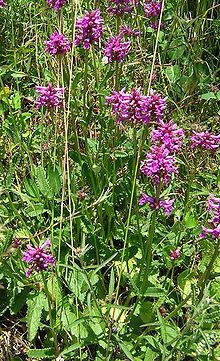Betonica officinalis
| Stachys officinalis | |
|---|---|
 |
|
| Scientific classification | |
| Kingdom: | Plantae |
| (unranked): | Angiosperms |
| (unranked): | Eudicots |
| (unranked): | Asterids |
| Order: | Lamiales |
| Family: | Lamiaceae |
| Genus: | Stachys |
| Species: | S. officinalis |
| Binomial name | |
|
Stachys officinalis (L.) Trevis. ex Briq. |
|
| Synonyms | |
|
Betonica officinalis L. |
|
Betonica officinalis L.
Stachys officinalis is commonly known as common hedgenettle,betony, purple betony, wood betony, bishopwort, or bishop's wort. The French common name is betoine, and Betonie in German. It is a perennial grassland herb growing to 1 to 2 feet tall.
Pliny (25, 8, 46, § 84) calls the plant both betonica and vettonica, claiming that the Vettones used it as a herbal medicine. The word stachys comes from the Greek, meaning "an ear of grain," and refers to the fact that the inflorescence is often a spike.
Stachys officinalis is a perennial grassland herb growing to 30 to 60 cm (1 to 2 ft) tall. Its leaves are stalked on upright stems, narrowly oval, with a heart-shaped base, with a somewhat wrinkled texture and toothed margins. The calyx is 5–7 mm long, with 5 teeth, edged with bristles. The corolla 1–1.5 cm long. Its upper lip flat, almost straight when seen from the side. The anthers stick straight out. It flowers in mid summer from July to September, and is found in dry grassland, meadows and open woods in most of Europe, western Asia and North Africa. In the British Isles it is common in England and Wales, but rare in Ireland and northern Scotland.
The aerial parts contain phenylethanoid glycosides, (betonyosides A-F) and acetoside, acetoside isomer, campneosides II, forsythoside B and leucosceptoside B. The roots contain diterpene glycosides, betonicosides A-D and the diterpene, betonicolide.
...
Wikipedia
